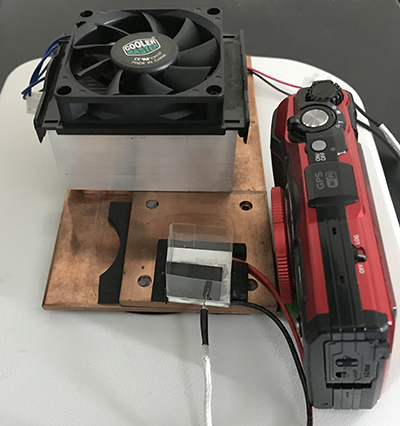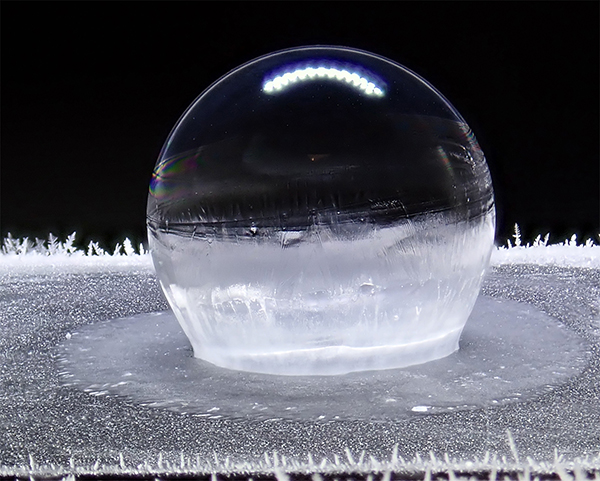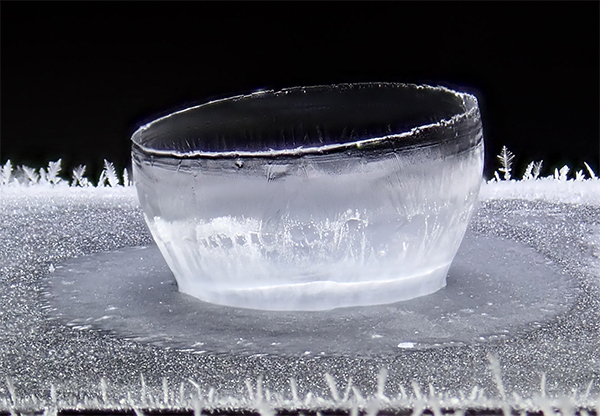
|
Bubble fun: When soap bubbles meet a cold Peltier plate. by David Walker, UK |

I was recently watching the first episode of the BBC TV seasonal nature series "Winterwatch"*
for 2020/21 and the opening sequence presented by the naturalist Chris Packham showed some short but striking footage. A large soap bubble blown and placed on snow outside immediately started to grow snow crystals and danced around in the water film. He remarked that temps below -11șC are required although after some Googling this maybe somewhat variable**. A number of photographers have shared similar striking examples online e.g. in Facebook macro groups taken outside including in the north of England where
they reported the outside
temps were a modest -3șC. With a current interest in exploring the use of Peltier plates as cold stages (see links below), I wondered if it was possible to create something similar albeit on a smaller scale with indoor comfort. So without further ado ... try it and see!
*Available to watch for UK viewers until the end of 2021.
** The freezing point may depend on the soap bubble recipe used; a variety are shared online with variable detergent concentrations and some include glycerine.
The simple setup is shown on the right which was already in use for surface frost formation studies indoors. It was sat on the stereo scope base to make use of the 144 LED ringlight but vertical imaging with the stereo was not ideal and with low depth of field. An Olympus TG5 was used as shown in Microscope mode; a supermacro mode where it takes a stack of five images and combines in the camera. A perspex collar kept the air around the plate colder. The Peltier plate was set to its max rating giving a surface plate temp of ca -11șC.

The results were rather mixed but the best complete bubble ca. 5 mm across is shown above. The surrounding temp likely prevented the bubble from freezing entirely. Fortuitously, this example sat on a previously collapsed and frozen bubble.

Many of the bubbles popped early, the one shown did to form a small ice cup.
So not quite the striking effects shown on the BBC and by photographers online for outdoor shots but had fun exploring!
Previous articles exploring Peltier plates
In the August 2015, April 2018 and May 2018 issues of Micscape I shared my trials of using Peltier plates, both solid and with a central hole to make cooling stages for hobbyist microscopy. A particular goal was to be able to study water freezing under a coverslip with indoor comfort which was successful with later designs. Studying frost formation on solid plates was also fascinating.
Peltier plates can also be used for heating, either by having the hot side uppermost or using a cooling stage design and reversing the polarity of the power supply. Early trials of using both a solid and annular plate in this mode are summarised in a January 2021 article but these trials suggested that the type of plates used were unsuited for reliable heating.
Comments to the author David Walker are welcomed.
Published in the February 2021 edition of Micscape.
Please report any Web problems or offer general comments to the Micscape Editor .
Micscape is the on-line monthly magazine of the Microscopy UK web site at Microscopy-UK
© Onview.net
Ltd, Microscopy-UK, and all contributors 1995 onwards. All rights
reserved.
Main site is at www.microscopy-uk.org.uk
with full mirror at
www.microscopy-uk.net
.